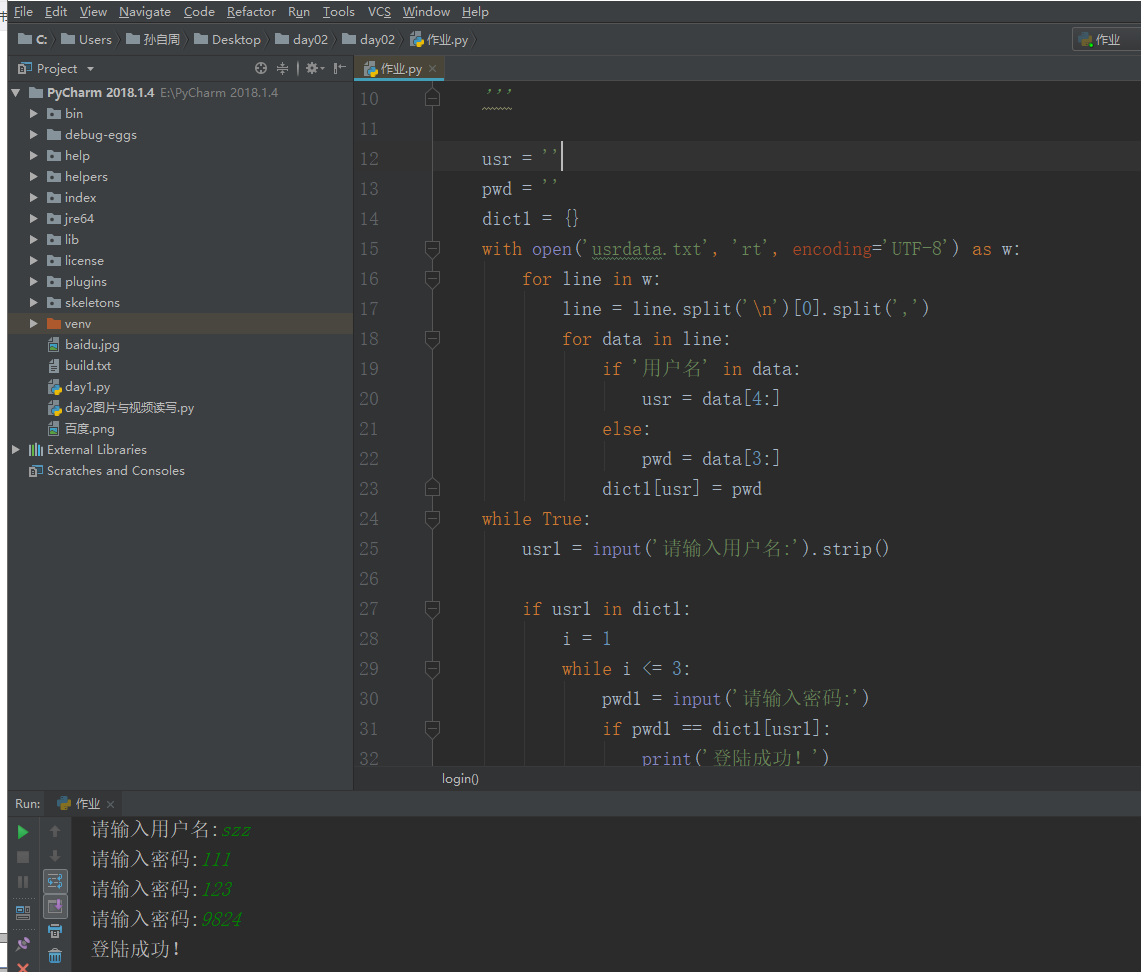学习内容:
# # 列表类型: # # 1.insert() # 插入 # # 第一个参数: 索引 第二个参数: 插入的值 # list1 = ['tank', 18, 'male', 3.0, 9, '广东', 'tank', [1, 2]] # # list1.insert(2, 'oldboy') # # print(list1) # # # 2.pop() # 取出 # # 3.remove() # 移除 # # # 4.count() # 查看某个值的个数 # print(list1.count('tank')) # # # 5.index() # 查看值的索引 # print(list1.index('广东'), '---广东') # # # 6.clear() # 清空列表的值 # list1.clear() # print(list1) # # # # 7.copy() # 浅拷贝 # # 将list1的内存地址浅拷贝赋值给list2 # list2 = list1.copy() # print(list2, '添加值前') # # # 将list1的原地址直接赋值给了list3 # list3 = list1 # print(list3, '添加值前') # # # 深拷贝() # from copy import deepcopy # # 将list1的值深拷贝赋值给list4 # list4 = deepcopy(list1) # # # 追加jason到list1中国 # list1.append('jason') # # print(list2, '添加值后') # print(list3, '添加值后') # # # 给list1中的可变列表进行追加值 # list1[8].append('tank') # # # 打印直接赋值、深、浅拷贝的结果 # # 浅拷贝: list1的列表中外层值改变对其不影响 # # 但对list1中的可变类型进行修改则会随之改变值 # print(list2) # print(list3) # # # 深拷贝: 把list1中的所有值完全拷贝到一个新的地址中 # # 进而与list1完全隔离开 # print(list4) # # # # 8.extend() # 合并 # list1 = [1, 2, 3] # list2 = [4, 5, 6] # list1.extend(list2) # print(list1) # # # 9.reverse() # 反转 # list1.reverse() # print(list1) # # # 10.sort() # 排序 # list3 = [1, 3, 5, 8, 10, 2, 4, 6] # # 升序 # # list3.sort() # # print(list3) # # # 降序 # list3.sort(reverse=True) # print(list3) # tab : 往右空四个空格 # shift + tab : 往左减四个空格 # 一 字典的内置方法(字典是无序的) # # 1、按照key取/存值 # dict1 = {'name': '张琦', 'age': 18, 'sex': 'male', 'school': '安徽工程大学'} # # # 根据key取张琦的学校 # print(dict1['school']) # print(dict1['sal']) # # # get() # # 第一个参数是字典的key # # 第二个参数是默认值,若key存在则取key对应的值,否则取默认值 # print(dict1.get('school', '华南理工大学')) # print(dict1.get('sal', '15000')) # # # 2、len # print(len(dict1)) # 4 # # # 3、成员运算in和not in # print('name' in dict1) # True # print('sal' in dict1) # False # print('sal' not in dict1) # True # # # 4、删除 # del dict1["name"] # print(dict1) # # # pop() # # 根据字典中的key取出对应的值赋值给变量name # name = dict1.pop('name') # print(dict1) # print(name) # # # 随机取出字典中的某个值 # dict1.popitem() # print(dict1) # # # 5、keys、values、items # print(dict1.keys()) # print(dict1.values()) # print(dict1.items()) # # # 6、循环 # # 循环字典中所有的key # for key in dict1: # print(key) # # # 7、update() # print(dict1) # dict2 = {"work": "student"} # # 把dict2加到dict1字典中 # dict1.update(dict2) # print(dict1) # 二 元组类型(在小括号内,以逗号隔开存放多个值) # 注意: 元组与列表的区别,元组是不可变类型,列表是可变类型。 # tuple1 = (1, 2, 3, 4, 5, 6) # print(tuple1) # # 优先掌握 # # 1.按索引取值 # print(tuple1[2]) # # # 2.切片(顾头不顾尾) # print(tuple1[0:6]) # (1, 2, 3, 4, 5, 6) # # # 步长 # print(tuple1[0:6:2]) # (1, 3, 5) # # # 3.长度 # print(len(tuple1)) # 6 # # # 4.成员运算 in 和 not in # print(1 in tuple1) # True # print(1 not in tuple1) # False # # # 5.循环 # for line in tuple1: # print(line) # 三 集合类型(一般用于去重) # 在{}以逗号隔开,可存放多个值,但集合会自带默认去重功能。 # set1 = {1, 2, 3, 4, 2, 1, 3, 4} # print(set1) # # # 集合是无序的 # set1 = set() # set2 = {} # print(set1) # print(set2) # # set2['name'] = 'tank' # print(type(set2))
# 文件读写基本使用 # 对文本进行操作 # open(参数1: 文件的绝对路径/文件的名字,参数2:操作模式, 参数3: 指定字符编码) # f: 称之为 句柄 # r: 避免转义符 # 打开文件会产生两种资源,一种是python解释器与python文件的资源,程序结束python会自动回收。 # 另一种是操作系统打开文件的资源,文件打开后,操作系统并不会帮我们自动收回,所以需要手动回收资源。 # 写文件 f = open( r'/python相关/python_files/安徽工程/files/文件的名字.txt', mode="wt", encoding="utf-8") f.write('hello 安徽工程大学') f.close() # 读文件 f = open( r'/python相关/python_files/安徽工程/files/文件的名字.txt', 'r', # 默认rt encoding='utf-8') res = f.read() print(res) f.close() # 文件追加模式 a f = open(r'/python相关/python_files/安徽工程/files/文件的名字.txt', 'a', # 默认at模式 encoding='utf-8' ) f.write('\nhello jason') f.close()
# 文件处理之上下文管理: with # with会自带close()功能, # 会在文件处理完以后自动调用close()关闭文件 # 写文件 with open(r'file1.txt', 'w', encoding='utf-8') as f: f.write('life is short, u need python!') # 读文件 with open(r'file1.txt', 'r', encoding='utf-8') as f: res = f.read() print(res) # 文件追加 with open(r'file1.txt', 'a', encoding='utf-8') as f: f.write('\n AAA')
import requests res = requests.get('https://www.baidu.com/img/bd_logo1.png') print(res.content) #写入图片 # with open('百度.png','wb') as f: # f.write(res.content) # # # #读取 # with open('百度.png','rb')as f : # res=f.read() # print(res) # #文件拷贝 # with open('百度.png','rb',)as f ,open('baidu.jpg','wb')as w: # res=f.read() # w.write(res) # 读写视频 # with open('tianyan_sys.mp4', 'rb') as f, open('tianyan_sys_copy.mp4', 'wb') as w: # res = f.read() # print(res) # w.write(res) # 一行一行读文件 # with open('tianyan_sys.mp4', 'rb') as f, open('tianyan_sys_copy.mp4', 'wb') as w: # 一次打开文件所有内容,若文件的大小超出内存的大小会导致内存溢出 # f.read() # 一行一行读取文件内容,一行一行写入文件中,避免内存溢出 # for line in f: # w.write(line) # res = f.read() # print(res) # w.write(res)
''' 1.函数相当于工具,需要事先准备好,在需要时在使用 2.如何使用函数? 函数必须先定义,后调用 3.函数语法 def 函数名(参数1,参数2,...): """ 函数声明 """ 函数体代码(逻辑代码) ''' ''' def:(全称define)用来声明定义函数的关键字 函数名:看其名,知其义 ():括号,存放的是接受外界的参数 注释:用来说明函数的作用 函数体代码:逻辑代码 return:后面跟函数返回值 ''' ''' 函数在定义阶段发生的事情: 1. 先打开python解释器 2. 加载.py文件 3. python会帮助我们检测语法,但是只会检测python语法,不会执行函数体代码 ''' # 注册功能 def register(): ''' 此函数注册功能 :return: ''' while True: user = input('请输入用户名:').strip() pwd = input('请输入密码:').strip() re_pwd = input('请输入密码:').strip() #strip是为了去除空格 if pwd == re_pwd: # 格式化字符串的三种方法: # user_info = '用户名:%s,密码:%s' % (user,pwd) user_info = '用户名:{},密码:{}'.format(user,pwd) # 字符串前面写一个f相当于调用format方法 # user_info = f'用户名:(user),密码:(pwd)' # 把用户信息写入文件中 with open('user.txt','w',encoding='utf-8') as f: # with open(f'{user}.txt','w',encoding='utf-8') as f: f.write(user_info) break else: print("两次密码不一致,请重新输入:") # 调用函数: 函数名() ,即调用函数 # 调用阶段会执行,函数体代码 register()
作业 :
# 测试用数据 with open('usrdata.txt', 'wt', encoding='UTF-8') as f: f.write('用户名:szz,密码:9824\n用户名:szz,密码:9824') def login(): ''' 登录函数 ''' usr = '' pwd = '' dict1 = {} with open('usrdata.txt', 'rt', encoding='UTF-8') as w: for line in w: line = line.split('\n')[0].split(',') for data in line: if '用户名' in data: usr = data[4:] else: pwd = data[3:] dict1[usr] = pwd while True: usr1 = input('请输入用户名:').strip() if usr1 in dict1: i = 1 while i <= 3: pwd1 = input('请输入密码:') if pwd1 == dict1[usr1]: print('登陆成功!') break else: i += 1 else: print('密码错误超过三次!') else: print('用户名不存在!') break login()
